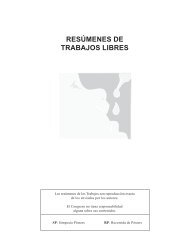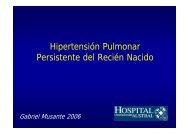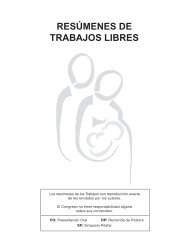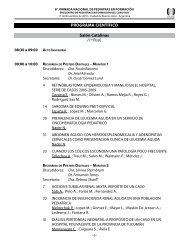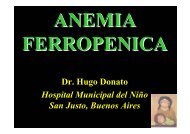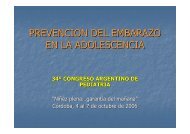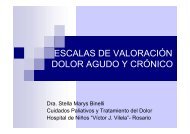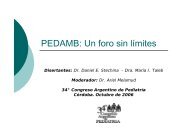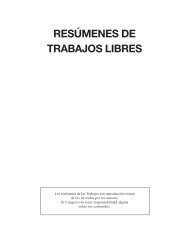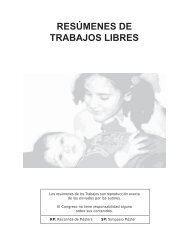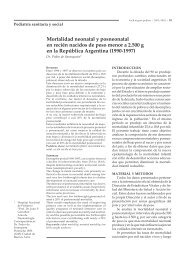Hidrops vesicular agudo: forma de presentación no habitual de ...
Hidrops vesicular agudo: forma de presentación no habitual de ...
Hidrops vesicular agudo: forma de presentación no habitual de ...
You also want an ePaper? Increase the reach of your titles
YUMPU automatically turns print PDFs into web optimized ePapers that Google loves.
134 COMENTARIO BREVE ARCH ARG PEDIATR<br />
Comunicación breve<br />
<strong>Hidrops</strong> <strong>vesicular</strong> <strong>agudo</strong>: <strong>forma</strong> <strong>de</strong><br />
presentación <strong>no</strong> <strong>habitual</strong> <strong>de</strong> hepatitis viral aguda tipo A<br />
Dres. DANIEL CREUS*, ELENA INSUA** y CARLOS GUTIERREZ**<br />
RESUMEN<br />
El hidrops <strong>vesicular</strong> <strong>agudo</strong> es una patología poco frecuente<br />
en la práctica pediátrica.<br />
Debe diferenciarse <strong>de</strong> la colecistitis aguda alitiásica, <strong>de</strong> la<br />
colelitiasis y <strong>de</strong>l síndrome <strong>de</strong> bilis espesa.<br />
Presentamos un niño con hepatitis viral aguda <strong>de</strong> tipo A,<br />
cuya <strong>forma</strong> <strong>de</strong> presentación fue dolor abdominal causado por<br />
hidrops <strong>vesicular</strong> <strong>agudo</strong>.<br />
Palabras clave: hidrops <strong>vesicular</strong>, hepatitis viral aguda.<br />
SUMMARY<br />
Acute hidrops of the gallblad<strong>de</strong>r is an unusual pathologic<br />
condition, that is encountered primarily in children.<br />
It must be differentiated from the acute acalculus cholecistitis,<br />
cholelythiasis and the bile-plug syndrome.<br />
We report a child with acute viral hepatitis, type A, which<br />
presentation form was with abdominal pain, secondary to acute<br />
hydrops of the gallblad<strong>de</strong>r.<br />
Key words: gallblad<strong>de</strong>r hydrops, acute viral hepatitis.<br />
ARCH ARG PEDIATR / 1998 / VOL. 96: 134<br />
INTRODUCCION<br />
<strong>Hidrops</strong> <strong>vesicular</strong> <strong>agudo</strong>, colecistitis aguda<br />
alitiásica y colecistitis litiásica son situaciones patológicas<br />
diferentes poco comunes en niños y, a<br />
menudo, confundidas entre sí.<br />
El hidrops <strong>vesicular</strong> <strong>agudo</strong> 1 se caracteriza por<br />
una distensión <strong>vesicular</strong> masiva, en un niño agudamente<br />
enfermo, en ausencia <strong>de</strong> mal<strong>forma</strong>ciones<br />
congénitas, litiasis o infecciones bacterianas locales.<br />
2-4<br />
La colecistitis alitiásica aguda es una <strong>de</strong><strong>no</strong>minación<br />
frecuentemente usada como sinónimo <strong>de</strong><br />
hidrops <strong>vesicular</strong> <strong>agudo</strong>, <strong>de</strong>biendo ser reservada<br />
para casos <strong>de</strong> vesículas infectadas, sin cálculos,<br />
en un paciente con un cuadro <strong>de</strong> infección severa. 5<br />
La colecistitis litiásica aguda es me<strong>no</strong>s común<br />
en niños que en adultos, aunque con el advenimiento<br />
<strong>de</strong> la ultraso<strong>no</strong>grafía se <strong>de</strong>mostró que es<br />
más frecuente <strong>de</strong> lo que se pensaba, sobre todo en<br />
la adolescencia.<br />
Por último, po<strong>de</strong>mos mencionar, <strong>de</strong>ntro <strong>de</strong> los<br />
diagnósticos diferenciales, al síndrome <strong>de</strong> bilis<br />
espesa. 6 En éste se encuentra una obstrucción<br />
* Médico pediatra, médico ecografista.<br />
** Médico pediatra.<br />
Hospital Sub-zonal San Pedro.<br />
Correspon<strong>de</strong>ncia: Dr. Daniel Creus. Máximo Millán 1198. San<br />
Pedro, Pcia. Bs. As.<br />
extrahepática <strong>de</strong> la vía biliar por un espesamiento<br />
<strong>de</strong> la secreción biliar, generalmente en neonatos<br />
que presentan sepsis, <strong>de</strong>shidratación aguda,<br />
hemólisis masiva por incompatibilidad rh o ABO,<br />
fibrosis quística o nutrición parenteral total.<br />
Se presenta un niño <strong>de</strong> 6 años que ingresó a<br />
nuestro hospital con un cuadro <strong>de</strong> hidrops <strong>vesicular</strong><br />
<strong>agudo</strong>, se discutió acerca <strong>de</strong> las etiologías<br />
probables <strong>de</strong> dicha afección y se arribó a conclusiones<br />
acerca <strong>de</strong> la causa en nuestro paciente.<br />
HISTORIA CLINICA<br />
Niño <strong>de</strong> 6 años que ingresó por guardia, presentando<br />
dolor abdominal <strong>agudo</strong> y vómitos, se encontraba<br />
afebril y refirió malestar general en las últimas<br />
24 hs.<br />
En el examen físico se encontró a la palpación<br />
una tumoración dolorosa en el abdomen, que se<br />
extendía <strong>de</strong>s<strong>de</strong> el hipocondrio <strong>de</strong>recho hasta la<br />
altura <strong>de</strong>l ombligo. El resto <strong>de</strong>l abdomen se presentaba<br />
blando, <strong>de</strong>presible, sin reacción peritoneal,<br />
con ruidos hidroaéreos conservados.<br />
En la anamnesis <strong>no</strong> se recogieron datos relacionados<br />
con la enfermedad actual, y el resto <strong>de</strong>l<br />
examen físico <strong>no</strong> presentaba otros datos positivos.<br />
Se realizó por guardia una ecografía (con ecógrafo<br />
<strong>de</strong> tiempo real y escala <strong>de</strong> grises), en la que se<br />
observó leve hepatomegalia, vesícula alitiásica, <strong>de</strong><br />
pare<strong>de</strong>s finas y aumentada <strong>de</strong> tamaño con una
VOL. 96/1998 HIDROPS VESICULAR AGUDO: FORMA DE PRESENTACION NO HABITUAL DE HEPATITIS VIRAL AGUDA TIPO A<br />
135<br />
longitud <strong>de</strong> 9 cm y 3,5-4 cm <strong>de</strong> diámetros (Fotografía<br />
1). Bazo, riñones, páncreas <strong>de</strong> características<br />
ecográficas <strong>no</strong>rmales, <strong>no</strong> se visualizó líquido libre en<br />
cavidad peritoneal, <strong>de</strong>scartándose la presencia <strong>de</strong><br />
otras masas abdominales.<br />
Los estudios <strong>de</strong> laboratorio agregaron los siguientes<br />
resultados: hematocrito 32%; recuento <strong>de</strong><br />
glóbulos blancos: 8.700/mm 3 ; fórmula leucocitaria<br />
con predominio <strong>de</strong> linfocitos 52%; recuento <strong>de</strong><br />
plaquetas 195.000/mm 3 ; ERS: 32 mm 1ª hora;<br />
glucemia, uremia, io<strong>no</strong>grama <strong>no</strong>rmales; TGP: > 120<br />
UI/L; TGO: 60 UI/L; fosfatasa alcalina 1.100 UI/L;<br />
bilirrubina total 1,8 mg% y directa 0,9 mg%; investigación<br />
<strong>de</strong> Chagas por ELISA: negativo; hepatitis B y<br />
C por ELISA: negativo; HIV: negativo. Anticuerpos<br />
anti-virus <strong>de</strong> hepatitis A IgM positivo.<br />
El paciente se mantuvo en ayu<strong>no</strong> con hidratación<br />
parenteral las primeras 48 horas. Los controles<br />
<strong>de</strong> medio inter<strong>no</strong> permanecieron <strong>no</strong>rmales y,<br />
ecográficamente, se observó una paulatina disminución<br />
<strong>de</strong>l tamaño <strong>vesicular</strong> que, al cabo <strong>de</strong> 3 días,<br />
se encontraba en valores <strong>no</strong>rmales (Fotografía 2),<br />
con persistencia <strong>de</strong> leve hepatomegalia. La remisión<br />
<strong>de</strong> la sig<strong>no</strong>sintomatología fue total entre el<br />
tercer y cuarto día, tolerando bien la alimentación.<br />
En ningún momento presentó ictericia, coluria ni<br />
hipocolia.<br />
Se controló ambulatoriamente hasta la <strong>no</strong>rmalización<br />
<strong>de</strong>l hepatograma.<br />
DISCUSION<br />
El hidrops <strong>vesicular</strong> <strong>agudo</strong> es una patología poco<br />
común; se la encuentra en la literatura pediátrica<br />
como acompañante o siendo consecuencia <strong>de</strong> diferentes<br />
entida<strong>de</strong>s <strong>no</strong>sológicas <strong>de</strong> base. 5,7-11 La edad <strong>de</strong><br />
presentación varía <strong>de</strong>s<strong>de</strong> el nacimiento hasta los 15<br />
años, encontrándose con mayor frecuencia alre<strong>de</strong>dor<br />
<strong>de</strong> los 5 años. Es posible encontrar hidrops <strong>vesicular</strong><br />
durante el transcurso o en la convalecencia <strong>de</strong> infecciones<br />
respiratorias, otitis media y gastroenteritis. 4-12<br />
También se lo encuentra <strong>de</strong>scripto en el síndrome <strong>de</strong><br />
Kawasaki, las infecciones estreptocócicas, las<br />
leptospirosis y la linfoa<strong>de</strong>nitis mesentérica. 13 La causa<br />
<strong>de</strong> la distención <strong>vesicular</strong> masiva es incierta, aunque<br />
se sugiere que pue<strong>de</strong> ser secundaria a una obstrucción<br />
transitoria y autolimitada <strong>de</strong>l conducto cístico,<br />
habiéndose encontrado en algu<strong>no</strong>s casos hiperplasia<br />
<strong>de</strong> los ganglios linfáticos adyacentes a la unión <strong>de</strong>l<br />
cístico con el hepatocolédoco, causando una obstrucción<br />
mecánica, o bien reacción inflamatoria <strong>de</strong>l conducto<br />
cístico frente a esta linfa<strong>de</strong>nitis. 2-4 El síndrome<br />
<strong>de</strong> Kawasaki 10 es una enfermedad <strong>de</strong> baja prevalencia<br />
en niños, en la cual el hidrops <strong>vesicular</strong> es un hallazgo<br />
<strong>de</strong>scripto como típico <strong>de</strong> la afección.<br />
La hepatitis viral aguda es una enfermedad muy<br />
frecuente en la población pediátrica, en la cual es<br />
común observar una amplia variedad <strong>de</strong> hallazgos en<br />
cuanto a síntomas y sig<strong>no</strong>s clínicos. Todos los autores<br />
refieren la aparición <strong>de</strong> dolor abdominal, náuseas,<br />
vómitos, sig<strong>no</strong> <strong>de</strong> Murphy positivo, hepatomegalia,<br />
FOTOGRAFÍA 1 FOTOGRAFÍA 2
136 COMENTARIO BREVE ARCH ARG PEDIATR<br />
a<strong>de</strong><strong>no</strong>megalias y esple<strong>no</strong>megalia, pero sólo hay dos<br />
casos <strong>de</strong> hidrops <strong>vesicular</strong> <strong>agudo</strong> comunicados en la<br />
literatura. 14 Sería <strong>de</strong> interés estudiar si, en realidad, el<br />
hidrops <strong>vesicular</strong> <strong>agudo</strong> <strong>no</strong> es algo más que un hallazgo<br />
y si <strong>no</strong> se trata <strong>de</strong> una alteración frecuente pero <strong>no</strong><br />
<strong>de</strong>scripta, hasta el momento, <strong>de</strong>ntro <strong>de</strong> la historia<br />
natural <strong>de</strong> la enfermedad.<br />
El presente caso clínico se trató <strong>de</strong> un paciente<br />
con una hepatitis viral aguda tipo A cuya <strong>forma</strong> <strong>de</strong><br />
comienzo fue dolor abdominal causado por un<br />
hidrops <strong>vesicular</strong> <strong>agudo</strong>. Encontramos sólo una<br />
<strong>de</strong>scripción <strong>de</strong> esta <strong>forma</strong> <strong>de</strong> comienzo <strong>de</strong> hepatitis<br />
viral en la literatura, por lo que consi<strong>de</strong>ramos que<br />
esta comunicación cobra particular interés. ❚<br />
BIBLIOGRAFIA<br />
1. Kumari S, Lee WS, Baron MG. Hydrops of the gallblad<strong>de</strong>r in a<br />
child; diag<strong>no</strong>sis by ultrasound. Pediatrics 1979; 63: 295-297.<br />
2. Chamberlain JW, Hight DW. Acute hydrops of the gallblad<strong>de</strong>r.<br />
Am J Dis Child 1980; 134: 891-892.<br />
3. New J, Arvin A, Ariag<strong>no</strong> RL. Hydrops of the gallblad<strong>de</strong>r. Am J Dis<br />
Child 1980; 134: 891-892.<br />
4. Rumley TO, Rodpers BM. Hydrops of the gallblad<strong>de</strong>r in children.<br />
J Pediatr Surg 1983; 18: 138-140.<br />
5. Temberg LS, Keating SP. Acute acalculus cholecystitis<br />
complication of other illnesses in childhood. Arch Surg 1975,<br />
110: 543-547.<br />
6. Pheiffer WR, Robinson LH, Balsara VJ. So<strong>no</strong>graphic features of<br />
bile plug syndrome. J Ultrasoud Med 1986; 5: 161-164.<br />
7. Armspiger LA, Martín JG, Krempin HO. Acute <strong>no</strong>n calculus<br />
cholecyistitis in children. Am J Surg 1960; 100: 103-106.<br />
8. Callahan J, Haller JO, Cacciarelli AA, Slovis TL. Colelithiasis in<br />
infants, association with total parenteral nutrition and furosemid.<br />
Radiology 1982; 143: 437-490.<br />
9. Greenberg M, Kamgarloo H, Cochran ST, Sample WF. The<br />
ultraso<strong>no</strong>graphic diag<strong>no</strong>sis of cholecystitis and cholelithiasis in<br />
children. Radiology 1980; 137: 745-749.<br />
10. Grisoni E, Fisher R, Izant R. Kawasaki syndrome: Report of four<br />
cases with acute gallblad<strong>de</strong>r hydrops. J Pediatr Surg 1984; 19:<br />
9-11.<br />
11. Dinulos J, Mitchel D, Egerton J, Pickering L. Hydrops of the<br />
gallblad<strong>de</strong>r associated with Epstein-Barr virus infection: a report<br />
of two cases and review of the literature. Pediatr Infect Dis J<br />
1994; 13: 924-929.<br />
12. Tamayo Lopez G et al. Hydrops of the gallblad<strong>de</strong>r in childhood.<br />
An Esp Pediatr 1997; 47: 188-190.<br />
13. Barton LL et al. Hydrops of the gallblad<strong>de</strong>r in childhood infection.<br />
Pediatric Infect Dis J 1995; 14: 163-164.<br />
14. Mc Gahan JJ, Whittngill JA. Acute idiopatic hydrops of the<br />
gallblad<strong>de</strong>r <strong>no</strong>t due to calculi, possibly to infectious hepatitis.<br />
Report of two cases in neighboring children. Pediatrics 1958; 21:<br />
91-93.



